Planet Orbit and Declination Circles
Earth’s obliquity changes in a cyclical pattern, and the planets in our solar system and the exoplanets display a wide range of obliquities. You don’t need to use a computer program to estimate the planet’s seasonal temperature patterns – hand draw and interpret declination circles. Use the north-south trending template since all you need is a straight edge to draw lines. Download a pdf here.
Recommended Prerequisite Activities
For information about drawing declination circles for use on Earth, see Drawing Declination Circles.
To explore how to interpret declination circles, see Declination, Latitude, and Earth Illumination.
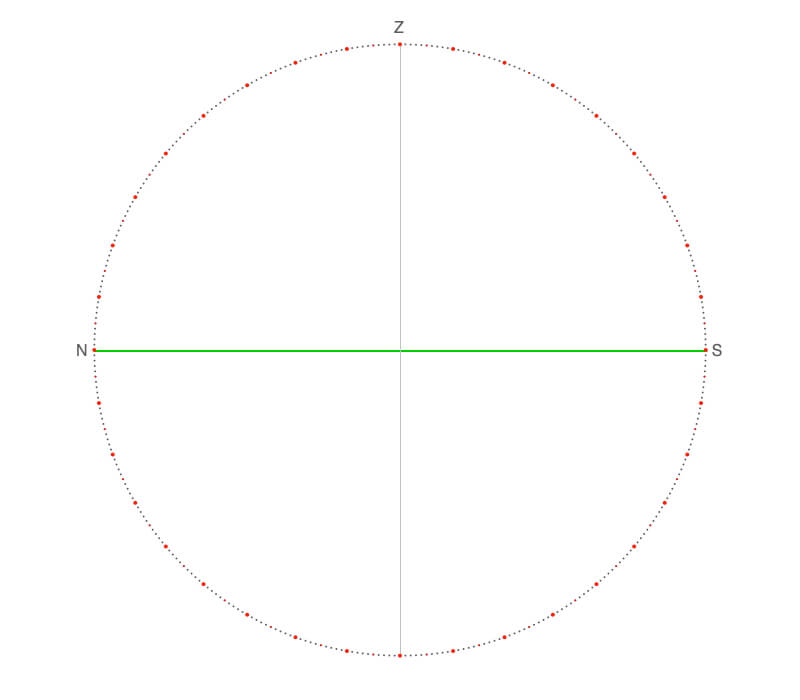
Example of the north/south-oriented declination circle template.
Drawing a Declination Circle for a Planet
To draw a declination circle, we need to know the latitude and solar declination. The solar declination requires knowing the planet’s obliquity, eccentricity, and precession, as well as the location in its orbit. However, the range of declination is always twice the obliquity. We can now draw three declination circles that show the patterns of the Sun’s movement during the year.
First, the equinox declination circle only depends on the latitude. To draw the solstice declination circles, use the planet’s obliquity and the equinox declination circle. For Earth, we used ±23.5º from the equinox declination circle.
If the planet’s obliquity were 0º and you were living at 30ºS, the star would appear to move in the same path every day of the year where:
-
- the sun would be 60º above the horizon at local noon each day,
- each day would have 12 hours of daylight and darkness, and
- the Sun would rise exactly east and set exactly west each day.
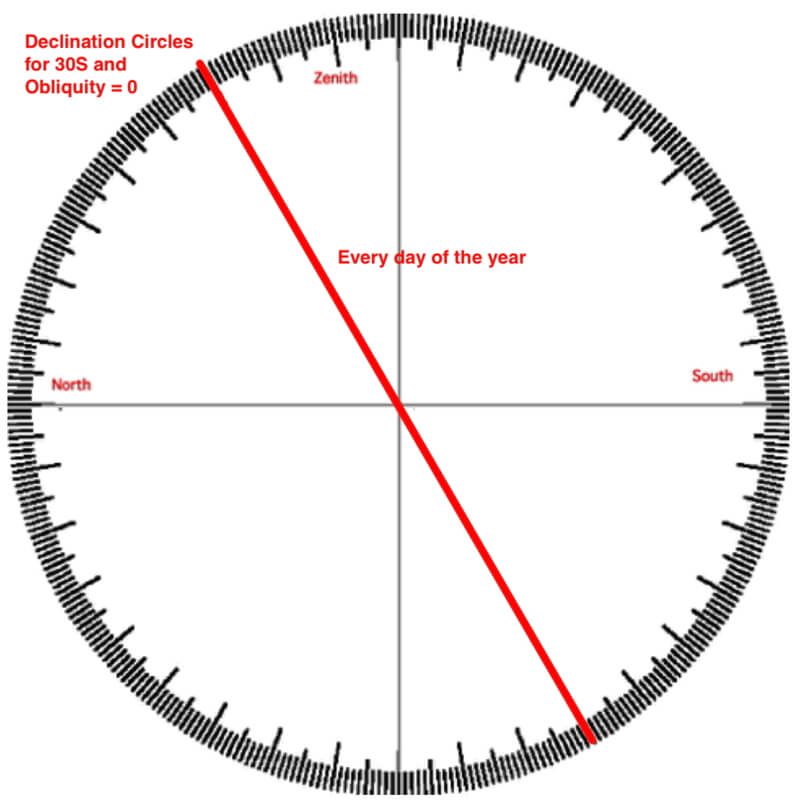
A declination circle for 30ºS when the planet’s obliquity is 0º.
If the obliquity were 90º and living at 30ºS? The equinox declination circle is the same as above, but now go +90º (toward the north) from local noon and midnight to draw the declination circle for the southern hemisphere’s winter solstice, and -90º (toward the south) for the southern hemisphere’s summer solstice. This creates a point for each solstice – the star will appear at 30º above the horizon and due south for 24 hours during the summer solstice. During the southern hemisphere’s winter solstice, the star will be 30º below the horizon and due north for 24 hours. Imagine how the seasons would change throughout the year given this amount of change in declination circles!
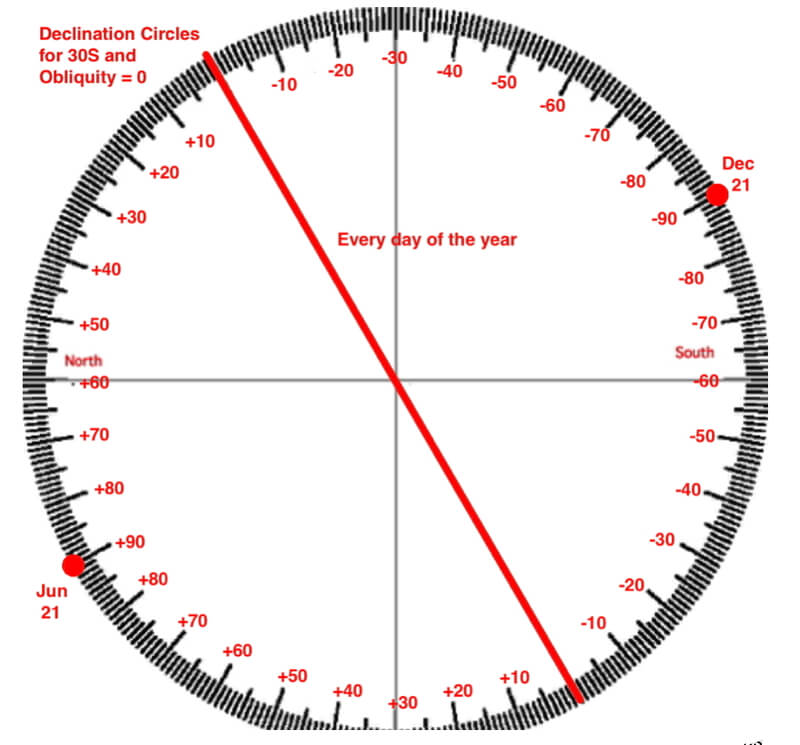
Three declination circles for 30ºS when the planet’s obliquity is 90º: equinoxes, summer solstice (June 21), and winter solstice (December 21).
Tropic Circles
Earth has two tropic circles, the Tropic of Cancer (23.5ºN) and the Tropic of Capricorn (23.5ºS). These are the most poleward latitudes where the Sun will be overhead at local noon at some time during the year. Between the two latitudes, the Sun will be overhead twice a year, and poleward, the Sun will never be overhead. But what happens when the planet’s obliquity is different than Earth’s 23.5º? The latitudes change!
When the obliquity is 0º, the Sun is only overhead at the equator (0º). As the obliquity increases, more of the Earth experiences the Sun directly overhead at local noon at some time during the year. The extreme is an obliquity of 90º in which the entire planet experiences a 90º local noon sun angle at least once during the year.
Notice that when the obliquity is 45º or more, the Sun won’t set during the summer solstice.
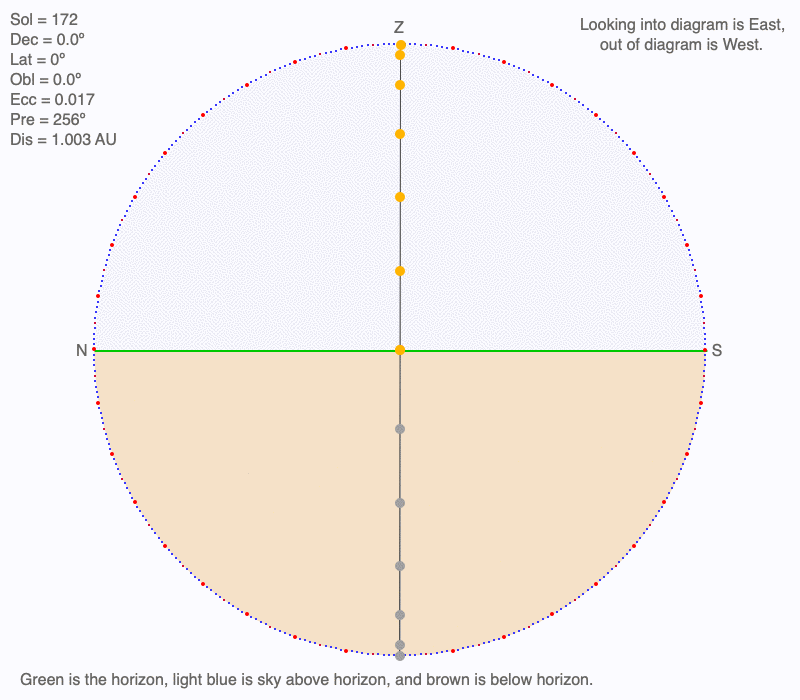
Animation of how the tropic circle latitudes change as a planet’s obliquity increases. A tropic circle experiences the Sun overhead at local noon during the summer solstice.
Polar Circles
Earth has two polar circles, the Arctic Circle (66.5ºN) and the Antarctic Circle (66.5ºS). These are the most equatorward latitudes where the Sun will not set during the summer solstice. Poleward, the Sun will have daylight for a period longer than 24 hours. Equatorward of the latitudes, there will always be some amount of darkness every 24 hours. As with the tropic circles, the polar circles depend on the obliquity.
When the obliquity is 0º, only the Poles experience extended periods of the Sun, although this is a bit fuzzy since the Sun remains on the horizon throughout the year. As the obliquity increases, more of the Earth experiences prolonged daylight during the summer and darkness in the winter. The extreme is an obliquity of 90º in which the entire planet experiences at least one day of full sunlight.
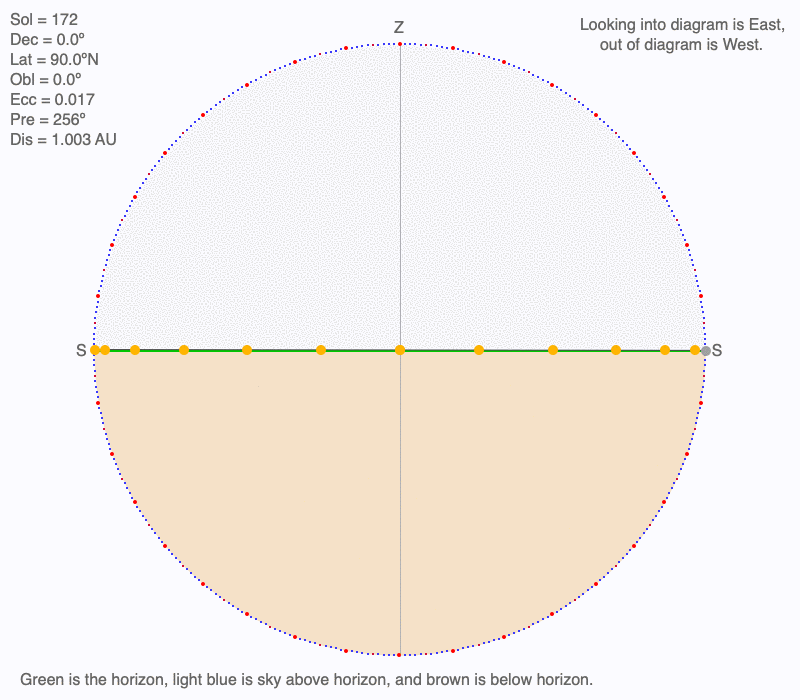
Animation of how the polar circle latitudes change as a planet’s obliquity increases. A polar circle is the lowest latitude that experiences 24 hours of daylight during the summer solstice.
A Tropic Circle and a Polar Circle?
When the obliquity is 45º, notice that 45ºN and 45ºS will be both tropic circles and polar circles. Poleward that sun will never be overhead, and equatorward, there won’t be days of 24 hours of sunlight.
When the obliquity is higher than 45º, the tropic circles are at a higher latitude than the polar circles!
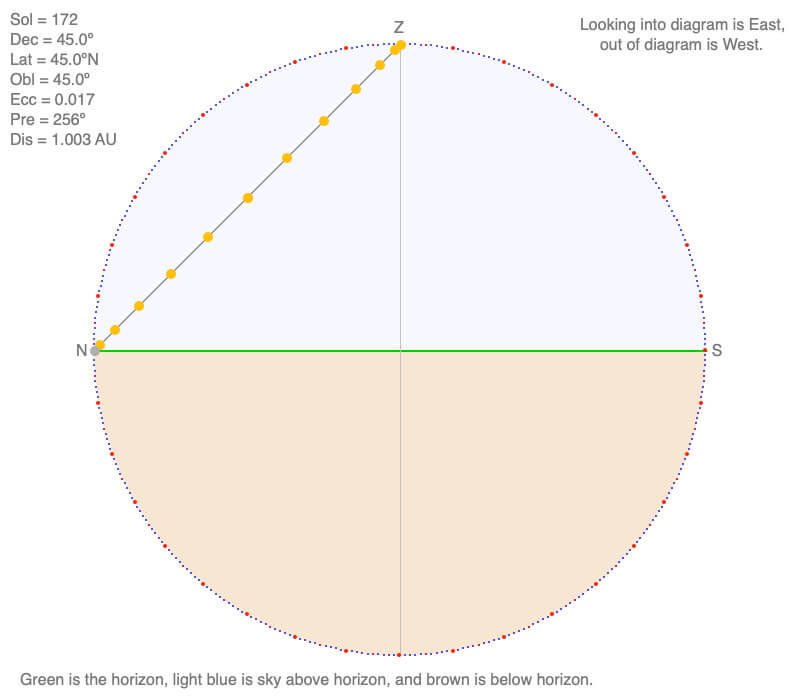
Declination circle for 45ºN during the summer solstice showing that the latitude is both the Tropic of Cancer and the Arctic Circle when the obliquity is 45º.
Big Ideas
- To draw a declination circle, we need to know the latitude and solar declination.
- Solar declination requires knowing the planet’s obliquity, eccentricity, and precession, as well as the location in its orbit. However, the range of declination is always twice the obliquity, so this is a good starting place.
- A planet’s obliquity defines the planet’s latitudes that the Sun will be directly overhead during that hemisphere’s summer solstice. On Earth, these latitudes are called the Tropic of Cancer (23.5ºN) and the Tropic of Capricorn (23.5ºS).
- A planet’s obliquity also defines the planet’s latitude that experiences 24 hours of darkness and sunlight once each year (90º – obliquity). These are called the Arctic Circle (66.5ºN) and the Antarctic Circle (66.5ºN).

0 Comments